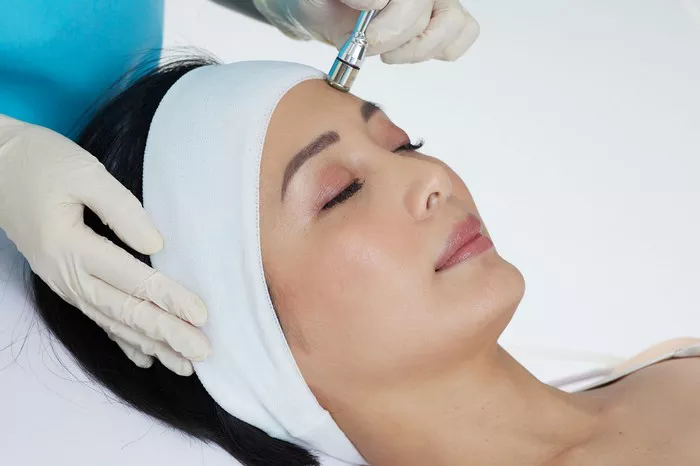Microdermabrasion is a popular non-invasive cosmetic procedure that aims to improve the appearance of the skin. It involves the use of a device that exfoliates the outermost layer of the skin, helping to reveal a smoother, brighter, and more youthful complexion. In this article, we will explore what microdermabrasion does to your skin, highlighting the key benefits and considerations associated with this treatment.
Understanding Microdermabrasion
Microdermabrasion is a skin resurfacing technique that uses a handheld device to gently exfoliate the outer layer of the skin. The device typically utilizes tiny crystals or a diamond-tipped wand to slough off dead skin cells and suction them away, promoting cellular turnover and revealing fresher, healthier skin underneath.
The procedure is usually performed by a trained aesthetician or dermatologist and can be customized based on the individual’s specific skin concerns and needs. It is commonly used to address concerns such as fine lines, wrinkles, acne scars, uneven skin tone, sun damage, and clogged pores.
Benefits of Microdermabrasion
-
Exfoliation and Cellular Renewal
Microdermabrasion provides effective exfoliation, helping to remove dead skin cells from the surface of the skin. By eliminating these dull and damaged cells, it stimulates cellular renewal and encourages the growth of new, healthier skin cells. This can result in a smoother, more vibrant complexion.
-
Improved Texture and Tone
Microdermabrasion can help improve the overall texture and tone of the skin. It can minimize the appearance of fine lines, wrinkles, and acne scars, as well as reduce hyperpigmentation and age spots. With regular treatments, it can promote a more even and youthful skin tone.
-
Enhanced Product Penetration
By exfoliating the outer layer of the skin, microdermabrasion enhances the penetration and absorption of skincare products. This means that moisturizers, serums, and other topical treatments can better penetrate the skin, maximizing their effectiveness and providing more noticeable results.
-
Stimulated Collagen Production
Microdermabrasion can stimulate collagen production in the skin. Collagen is a protein that helps maintain the skin’s structure and elasticity. By promoting collagen production, microdermabrasion can improve the firmness and elasticity of the skin, reducing the appearance of sagging or loose skin.
-
Reduced Pore Size
Microdermabrasion can help unclog and minimize the appearance of enlarged pores. By removing dead skin cells and impurities, it can clear out debris that can contribute to pore congestion. This can result in a smoother skin texture and a reduced likelihood of blackheads and breakouts.
-
Quick and Convenient
Microdermabrasion is a relatively quick and convenient procedure. Depending on the size of the treatment area, a session typically takes around 30 minutes to an hour. It is often referred to as a “lunchtime” procedure because it requires minimal downtime, allowing individuals to resume their normal activities immediately after the treatment.
Considerations and Precautions
While microdermabrasion offers numerous benefits, there are a few considerations and precautions to keep in mind:
-
Sun Protection
After microdermabrasion, the skin may be more sensitive to sunlight. It is crucial to protect the treated skin by applying sunscreen with a high SPF and avoiding excessive sun exposure. Sun protection helps prevent sunburn, hyperpigmentation, and other sun-related damage.
-
Multiple Sessions
To achieve the desired results, multiple sessions of microdermabrasion are usually recommended. The exact number of sessions will depend on the individual’s skin condition and goals. Typically, treatments are scheduled a few weeks apart to allow the skin to recover between sessions.
-
Temporary Side Effects
After microdermabrasion, some individuals may experience temporary side effects such as redness, mild swelling, and sensitivity. These effects typically subside within a few hours to a day. It is essential to follow post-treatment instructions provided by the skincare professional to ensure proper healing and minimize any discomfort.
-
Not Suitable for Certain Skin Conditions
Microdermabrasion may not be suitable for individuals with certain skin conditions such as active acne, rosacea, eczema, or dermatitis. It is important to consult with a skincare professional or dermatologist to determine if microdermabrasion is appropriate for your skin type and condition.
-
Individual Results May Vary
While microdermabrasion can provide significant improvements in skin texture, tone, and appearance, individual results may vary. Factors such as age, skin type, and overall skincare routine can influence the outcome of the treatment. It is important to have realistic expectations and communicate your goals with the skincare professional before undergoing the procedure.
Conclusion
Microdermabrasion is a non-invasive cosmetic procedure that offers a range of benefits for the skin. By promoting exfoliation, stimulating collagen production, and improving texture and tone, microdermabrasion can help individuals achieve a smoother, brighter, and more youthful complexion. It is a convenient and relatively quick treatment with minimal downtime. However, it is important to consider the necessary precautions, follow post-treatment instructions, and consult with a skincare professional to determine if microdermabrasion is suitable for your specific skin type and concerns. With proper care and regular treatments, microdermabrasion can be an effective addition to a skincare routine, contributing to healthier and more radiant skin.

